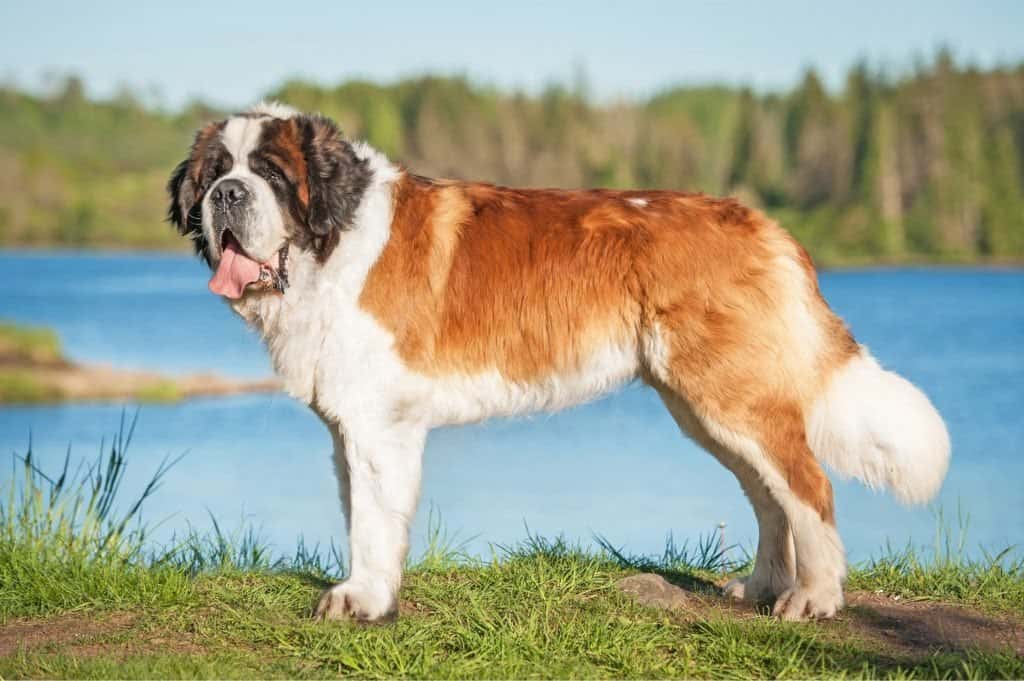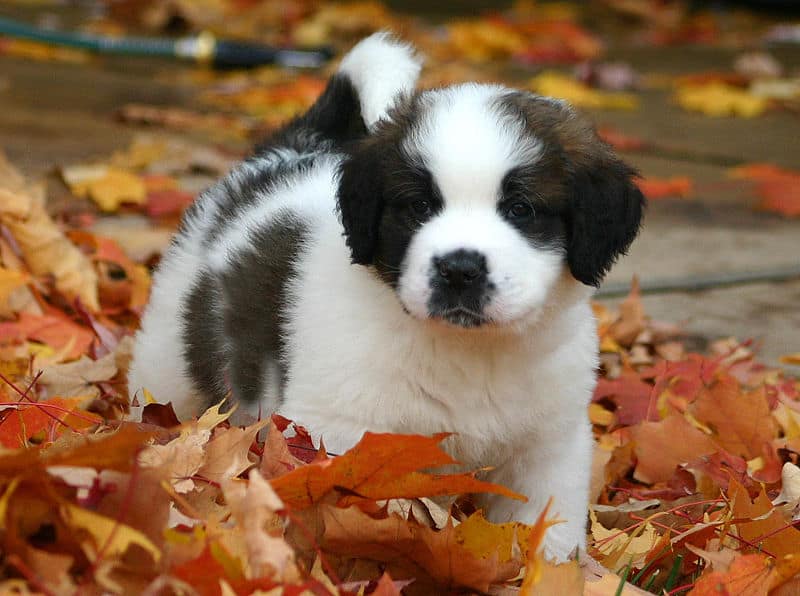The St. Bernard vs. the Great Dane: when comparing these two beloved breeds, who wins your heart?
St. Bernards weigh slightly more, have a stockier build, and may be long-haired. Great Danes have upright ears and are slim with deep chests. St Bernards may live slightly longer and do better with children, while Great Danes are more playful.
St. Bernards may require more grooming, particularly if they’re long-haired. They drool more abundantly as well but bark considerably less.
Let’s keep exploring these breeds below!
Comparing St Bernard vs Great Dane

| St. Bernard | Great Dane | |
|---|---|---|
| Size | 26-30 inches, 120-180 pounds | 26-30 inches, 110-175 pounds |
| Appearance | Stocky with short or long double coat and brachycephalic snout | Slim and deep-chested with a short coat and upright ears |
| Lifespan | 8-10 years | 7-10 years |
| Temperament | Protective, affectionate, great with children | Protective, affectionate, playful |
| Energy Level | Moderate | High |
| Grooming | Weekly brushing and combing | Weekly brushing |
| Drooling Level | Very high | High |
| Barking Level | Low | Moderate |
Key Differences Between St Bernard and Great Dane
The key difference between a St. Bernard and a Great Dane is appearance. Other differences include size, lifespan, temperament, energy level, grooming requirements, drooling, and barking.
Let’s dive in below to learn more about these popular giant breeds!
St Bernard vs Great Dane: Size

Saint Bernards tend to weigh more and often have longer coats than Great Danes.
©Rita_Kochmarjova/Shutterstock.com
Both breeds stand between 26-30 inches tall on average. The tallest dog ever was a Great Dane named Zeus, who stood 44 inches tall!
Great Danes have a slimmer body shape and usually weigh less than St. Bernards. Great Danes weigh 110-175 pounds, while St. Bernards weigh 120-180 pounds.
If you’d like to adopt a giant breed like these, it’s important to consider the drawbacks and benefits. Large dogs are more expensive and can be difficult to handle. However, they make great deterrents for burglars even when they don’t have guarding instincts like these breeds.
St Bernard vs Great Dane: Appearance
This is the most noticeable difference between these breeds. St. Bernards are stocky, muscular dogs with short to long fur. They have a brachycephalic snout, meaning their snout is bred to be short. This leads to health problems for the dogs, such as trouble breathing and an increased risk of heat stroke.
Great Danes are slimmer, with sprinter’s builds and deep chests. Their coat is always short and doesn’t tend to appear as thick as St. Bernards’ coats.
Great Danes often have upright ears, which isn’t natural, and it’s achieved through an inhumane practice called ear cropping.
In addition to these differences, these pups have different fur colors and patterns. The following are allowed under the St. Bernard breed standard:
- Brindle and white
- Brown and white
- Mahogany and white
- Orange and white
- Red and white
- Rust and white
- White and brown
- White and orange
- White and red
St. Bernards may also have black mask markings.
The Great Dane breed standard allows the following coat colors:
- Black
- Black and white
- Blue
- Brindle
- Fawn
- Harlequin
- Merle
- Silver
- White
- Mantle
Great Danes may have white markings, black markings, or a black mask.
St Bernard vs Great Dane: Lifespan

Saint Bernards also live longer lifespans of 8-10 years.
©dbking, CC BY 2.0, via Wikimedia Commons – Original / License
Unfortunately, giant breeds have the shortest lifespans of all dogs. St. Bernards live an average of 8-10 years, while Great Danes may live slightly shorter lives at 7-10 years.
These are averages, so some dogs will die younger while others will live years longer.
Providing excellent daily care is the best way to give your dog a healthy, long life. This includes a high-quality diet, daily exercise, and regular veterinary appointments.
St Bernard vs Great Dane: Temperament
Both dogs are extremely protective and may be wary of strangers. However, they’re big softies around their families. They might even try to snuggle by sitting on you like a lap dog!
Due to their brachycephalic snouts, St. Bernards don’t tend to be as active as Great Danes, and Great Danes are more playful and high-energy.
St. Bernards tend to be excellent with kids. This doesn’t mean Great Danes will do poorly with little ones, but they might have less patience or prefer kids from their own family to strangers.
A Great Dane can be trained to do well with children, and some St. Bernards might not like them! It’s important always to supervise children around dogs, so no one gets hurt.
Your pup and your child should be taught how to interact kindly with one another—no pulling ears, no jumping, and no rough play!
St Bernard vs Great Dane: Energy Level

St. Bernards need moderate daily exercise, while Great Danes need plenty! Both dogs have good endurance for long activities, but St. Bernards might do poorly with strenuous exercise or heat.
Nonetheless, St. Bernards can be quite clingy and will want to be doing whatever you are! They love being around their families.
Great Danes often seem like couch potatoes, but they require a lot of daily exercise and an enclosed area to sprint in! When they get the “zoomies” and take off running, you won’t be able to keep up!
St Bernard vs Great Dane: Grooming
Both breeds should be brushed once a week to reduce shedding. Long-haired St. Bernards will require more effort to groom, and you won’t be able to skip out on grooming. You can easily get away with missing a week or two with a Great Dane, though you’ll pay the price when they shed more around the house!
Long-haired St. Bernards can mat when not groomed properly, and this takes extra time with a comb rather than just going over their coat to remove loose fur with a brush.
St Bernard vs Great Dane: Drooling
While both breeds drool profusely, St. Bernards take the cake! You’ll constantly be cleaning up puddles, wiping their face, and probably finding their drool on your clothes.
Great Danes also drool more than the average dog, and you’ll clean up after them plenty!
St Bernard vs Great Dane: Barking

Great Danes bark more often than St. Bernards, though they don’t tend to be problem barkers when properly cared for.
©belu gheorghe/Shutterstock.com
St. Bernards seldom bark, and when they do, it’s likely to alert their owners to a threat—either real or perceived.
Great Danes are much more vocal, but they still bark only moderately. They are more prone to problem barking, particularly if you allow them to become bored.
If you come across it, the best way to solve problem barking is to ensure your pup gets plenty of attention, exercise, and mental stimulation throughout the day.
I suggest you rule out separation anxiety as a cause since these clingy breeds can be predisposed to it.
Once you’ve ruled out the above causes, you can work on training a “quiet” cue to get your dog to stop barking.
St Bernard vs Great Dane: Health
A few big health concerns for these breeds differ from one another. These include:
- St. Bernards are brachycephalic, meaning their short snouts cause difficulties breathing and other health problems. Brachycephalic dogs are poorly bred. I don’t recommend ever adopting these dogs from a breeder—but they can make amazing rescues!
- Merle, Harlequin, and white Great Danes can have health problems affecting their immune system, eyes, ears, and skin. I recommend never adopting from a breeder who breeds these dogs, as they’re certainly in it for the money rather than their puppies’ health.
- Both breeds have deep chests and thus a higher risk of bloat, which can be deadly. Bloat in dogs or Gastric Dilatation-Volvulus (GDV) Is when the dog’s stomach flips inside its body. This restricts blood flow and kills about 30% of affected dogs, even those who receive the best medical treatment.
It’s vital to know the signs of bloat and rush your pup to the nearest emergency clinic if they show symptoms. - Giant breeds are also predisposed to hip dysplasia and other joint problems, a problem for all large breed dogs. Breeders can and should screen for hip dysplasia. Your pup will have a good chance of developing arthritis as they age.
The photo featured at the top of this post is © iStock.com/gsagi
Ready to discover the top 10 cutest dog breeds in the entire world?
How about the fastest dogs, the largest dogs and those that are -- quite frankly -- just the kindest dogs on the planet? Each day, AZ Animals sends out lists just like this to our thousands of email subscribers. And the best part? It's FREE. Join today by entering your email below.
Thank you for reading! Have some feedback for us? Contact the AZ Animals editorial team.







